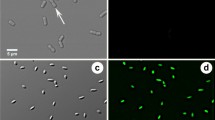Abstract
In the present work an immunocytochemical characterisation of four endophytic bacterial species has been made by using polyclonal antiserum produced against each of the four bacterial strains previously heated at 60 °C. The aim of this researchsito identify common elements among bacteria associated with their endophytic behaviour. Analysis of extracts of each strain by immunoblotting and ELISA confirmed the presence of proteins from different bacterial strains made up of common epitopes. However, antisaproduced againstHerbaspirillum seropedicae andBurkholderia ambifaria show a high number of bands recognised on each extracts, while antisera againstAzospirillum brasilense andGluconacetobacter diazotrophicus show a low number of bands recognised on each extract. Immunogold labelling showed that epitopes are located both on the cell wall and in the cytoplasm; most likely they could be preursor cell wall proteins synthesized inside the cytoplasm and subsequently transported onto cell wall. Finally, the common bands amog bacterial strains revealed by immunoblotting could play a role as active hydrolases involved in host tissue penetration.
Similar content being viewed by others
References
Baldani J.I., Baldani V.I.D., Seldin L., Döbereiner J. (1986). Characterization ofHerbaspirillum seropedicae gen. nov., sp. nov.: a root-associated nitrogen-fixing bacterium. Int. J. Syst. Bacteriol., 36: 86–93.
Bar T., Okon Y. (1992). Tryptophan conversion to indole-3-acetic acid via indole-3-acetamide inAzospirillum brasilense Sp7. Can. J. Microbiol. 39: 81–86.
Bradford M. (1976). A rapid and sensitive method for the quantitation of microgram quantities of protein utilizing the principle of protein-dye binding. Anal. Biochem., 72: 248–254.
Burbage D.A., Sasser M. (1982). A medium selective forPseudomonas cepacia. Phytopathology, Abstract 72: 706.
Burdman S, De Mot R., Vanderleyden J., Okon Y., Jurkevitch E. (2000). Identification and characterization of theomaA gene encoding the major outer membrane protein ofAzospirillum brasilense. DNA Sequence, 11: 225–257.
Burdman S., Dulguerova G., Okon Y., Jurkevitch E. (2001). Purification of the major outer membrane protein ofAzospirillum brasilense, its affinity to plant roots, and its involvement in cell aggregation. Mol. Plant-Microb. Inter., 14: 555–561.
Caballero-Mellado J., Carcaño-Montiel M.G., Mascarua-Esparza M.A. (1992). Field inoculation of wheat (Triticum aestivum) withAzospirillum brasilense
Laemmli U.K. (1970). Cleavage of structural proteins during the assembly of the head of bacteriophage T4. Nature, 227: 680–685.
Leclerc D., Asselin A. (1989). Detection of bacterial cell wall hydrolases after denaturing polyacrylamide gel electrophoresis. Can. J. Microbiol., 35: 749–753.
Leonardi D., Canini A., Forni C. (1993). Immunological comparison betweenArthrobacter isolates and bacteria living inAzolla filiculoides Lam Symbiosis, 15: 269–283.
Lerouxel O., Cavalier D.M., Liepman A.H., Keeqstra K. (2006). Biosynthesis of plant cell wall polysaccharides — a complex process. Curr. Opin. Plant Biol., in press.
Martinez-Dretz G., Del Gallo M., Burpee C., Burris R.H. (1984). Catabolism of carbohydrates and organic acids and expression of nitrogenase by azospirilla. J. Bacteriol. 159: 80–85.
Michiels K., Croes C., Vanderleyden J. (1991). Two different modes of attachment ofAzospirillum brasilense Sp7 to wheat roots. J. Gen. Microbiol. 137: 2241–2246.
Morgan J.A.W., Whipps J.M. (2001). Methodological approaches to the study of the rhizosphere carbon flow and microbial population dynamics. In: Pinton R., Varanini Z., Nannipieri P., Eds, The Rhizosphere: Biochemistry and Organic Substances at the Soil-Plant Interface. Marcel Dekker, New York, pp. 373–409.
Nakamura Y., Umemoto T., Nakatani Y., Namikawa I., Wadood A. (1993). Common and specific antigens of several treponemes detected by polyclonal antisera against major cellular proteins. Oral Microbiol. Immunol., 8: 288–294.
Olivares F.L., Baldani V.L.D., Reis V.M., Baldani J.I., Döbereiner J. (1996). Occurrence of the endophytic diazotrophsHerbaspirillum spp. in roots, stems and leaves, predominantly of Gramineae. Biol. Fertil. Soils, 21: 197–200.
Parke J.L., Gurian-Sherman D. (2001). Diversity of theBurkolderia cepacia complex and implications for risk assessments of biological control strains. Ann. Rev. Phytopathol., 39: 225–258.
Patrick C.C., Plaunt M.R., Sweet S.M., Patrick G.S. (1990). DefiningStaphylococcus epidermidis cell wall proteins. J. Clin. Microbiol., 28: 2757–2760.
Rambelli A. (1973). The rhizosphere of mycorrhizae. In: Marks G.L., Koslowski T.T., Eds., Ectomycorrhizae, their Ecology and Ehysiology. Academic Press, New York, pp. 299–349.
Reinhold-Hurek B., Hurek T. (1998). Life in grasses: diazotrophic endophytes. Trends Microbiol. 6: 139–144.
Reynolds E.S. (1963). The use of lead citrate at high pH as an electron-opaque stain in electron microscopy. J. Cell Biol., 17: 208–212.
Sprent J.I., James E.K. (1995). N2-fixation by endophytic bacteria: questions of entry and operation. In: Fendrik I., Del Gallo M., Vanderleyden J., De Zamaroczy M., Eds,Azospirillum VI and Related Microganisms, Heidelberg: Sprinter-Verlag, Berlin, pp. 15–30.
Urquiaga S., Cruz K.H.S., Boddey R.M. (1992). Contribution of nitrogen fixation to sugar cane: Nitrogen-15 and nitrogen balance estimates. Soil Sci. Soc. Am. J., 56: 105–114.
Whipps J.M. (1990). Carbon economy. In: Linch J.M., Ed., The Rizosphere, Chichester Wiley J. and Sons, New York, pp. 59–97.
Whipps J.M. (2001). Microbial interaction and biocontrol in the rhizosphere. J. Exper. Botany, 52: 487–511.
Whipps J.M., Lumsden R.D. (2001). Commercial use of fungi as plant disease biological control agents: status and prospects. In: Butt T., Jackson C., Magan N., Eds, Fungal biocontrol agents: progress, problems and potential. CABI Publishing, Wallingford, pp. 9–22.
Yamada Y., Hoshino K., Ishikawa T. (1997). The phylogeny of acetic acid bacteria based on the partial sequences of 16S Ribosomial RNA: the elevation of the subgenusGluconacetobacter to the generic level. Biosci. Biotech. Biochem., 61: 1244–1251.
Author information
Authors and Affiliations
Corresponding author
Rights and permissions
About this article
Cite this article
Canini, A., Canuti, L., Grilli Caiola, M. et al. Immunocytochemical characterisation of endophytic bacteriaAzospirillum brasilense, Herbaspirillum seropedicae, Burkholderia ambifaria andGluconacetobacter diazotrophicus . Ann. Microbiol. 56, 393–398 (2006). https://doi.org/10.1007/BF03175039
Received:
Accepted:
Issue Date:
DOI: https://doi.org/10.1007/BF03175039



